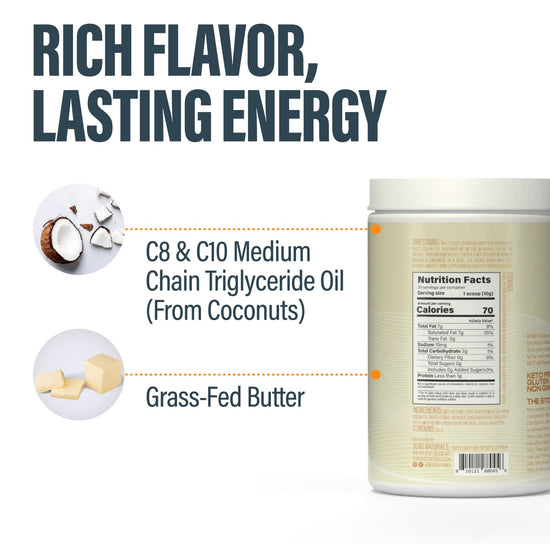Table of Contents
- Introduction
- Understanding Non-Dairy Creamers
- The Pros and Cons of Freezing Non-Dairy Creamers
- How to Freeze Non-Dairy Creamers
- Thawing Frozen Non-Dairy Creamers
- Frequently Asked Questions
- Conclusion
Introduction
Have you ever found yourself staring at a nearly full bottle of non-dairy creamer, wondering if you could freeze it for later use? You’re not alone. Many of us have experienced the dilemma of purchasing too much coffee creamer or finding ourselves with leftover creamers from holiday gatherings. This leads us to ask a crucial question: can you freeze non-dairy creamer?
In this blog post, we’ll explore the ins and outs of freezing non-dairy creamers, including the best methods to do so, how to thaw them properly, and what to expect in terms of taste and texture after freezing. This topic is not just about practicality; it’s also about reducing food waste and making the most of your grocery purchases.
At BUBS Naturals, we believe in adventure, wellness, and purpose. Just as we carefully select our ingredients for our clean, science-backed supplements, we want to help you navigate the world of food storage efficiently. By the end of this post, you will have a clear understanding of how to handle your non-dairy creamer, ensuring it serves you well for many cups of coffee to come.
We’ll cover the following aspects:
- An overview of non-dairy creamers and their ingredients.
- The pros and cons of freezing non-dairy creamers.
- Step-by-step instructions on how to freeze non-dairy creamer.
- Tips on how to thaw and use frozen non-dairy creamers.
- Frequently asked questions about freezing non-dairy creamers.
Let’s dive into the creamy world of non-dairy creamers and their freezing potential!
Understanding Non-Dairy Creamers
What Are Non-Dairy Creamers?
Non-dairy creamers are a popular alternative to traditional dairy creamers, catering to those who are lactose intolerant, vegan, or simply prefer plant-based options. Typically, these creamers are made from ingredients like:
- Vegetable oils: This is often the main ingredient in non-dairy creamers, providing a creamy texture without dairy.
- Corn syrup or sugar: These sweeteners help to replicate the taste of traditional creamers.
- Stabilizers and emulsifiers: Such as guar gum or carrageenan, which help maintain a smooth consistency.
The variety of flavors available, from classic vanilla to seasonal favorites like peppermint mocha, makes non-dairy creamers a versatile choice for coffee enthusiasts. However, it’s essential to check the ingredient label, as some brands may contain additives you might want to avoid.
Shelf Life of Non-Dairy Creamers
Most non-dairy creamers have a relatively short shelf life once opened, usually around 7 to 14 days in the refrigerator. Unopened, they can last several months, but once opened, it's crucial to consume them timely. This is where freezing comes into play as a practical solution to extend their usability.
The Pros and Cons of Freezing Non-Dairy Creamers
Pros
-
Extended Shelf Life: Freezing can significantly prolong the life of your non-dairy creamer, allowing you to enjoy it beyond its typical refrigerator shelf life.
-
Convenience: Having frozen portions ready to go means you can avoid waste and ensure you always have creamer on hand for your coffee needs.
-
Single-Serving Options: Freezing in ice cubes or smaller containers allows for convenient, single-serving portions—just the right amount for your morning brew.
Cons
-
Texture Changes: Freezing can cause some non-dairy creamers to change texture. You may notice separation or a grainy consistency once thawed, although this doesn’t typically affect the flavor significantly.
-
Limited Freezing Time: While non-dairy creamers can be frozen, they should ideally be used within three to six months for the best quality. Beyond that, the taste may start to deteriorate.
-
Not All Brands Are Created Equal: Some brands may not freeze as well as others. The composition of the creamer plays a significant role in how it reacts to freezing, so it’s wise to experiment with different brands.
How to Freeze Non-Dairy Creamers
Step-by-Step Instructions
-
Choose Your Container: Avoid freezing the original container as it may crack. Instead, opt for freezer-safe plastic bags or airtight containers. If using bags, try to remove as much air as possible before sealing.
-
Portion Control: If you want to freeze in single servings, consider using an ice cube tray. Pour the creamer into the tray and freeze until solid. Once frozen, pop out the cubes and transfer them into a freezer-safe bag, labeling it with the date.
-
Seal and Store: For larger portions, pour the creamer into a freezer-safe container, leaving a little space at the top for expansion. Seal tightly and label with the date.
-
Keep Track: It’s helpful to keep a record of how long the creamer has been frozen. Aim to use frozen non-dairy creamers within three to six months for the best taste and texture.
Tips for Freezing
- Shake Well Before Freezing: Give your creamer a good shake before you pour it into the container to ensure all ingredients are well combined.
- Consider Flavor Varieties: If you have different flavors, label each container or bag accordingly. This will save you time when you’re in the mood for a specific flavor.
Thawing Frozen Non-Dairy Creamers
Best Practices for Thawing
-
Refrigerator Thawing: The safest way to thaw frozen non-dairy creamer is to place it in the refrigerator overnight. This method helps maintain quality and reduces the risk of bacterial growth.
-
Direct Use: If you’ve frozen your creamer in ice cubes, you can drop the frozen cubes directly into your coffee. They will melt quickly, adding flavor without needing to thaw first.
-
Avoid Counter Thawing: Never thaw your creamer on the counter, as this can lead to spoilage. Always thaw in the refrigerator or use the direct method mentioned above.
-
Shake or Stir After Thawing: After thawing, you may notice some separation. Give it a good shake or stir to re-emulsify the ingredients.
How Long Can You Keep Thawed Creamer?
Once thawed, aim to use your non-dairy creamer within 48 hours for the best quality. If it was close to expiration when you froze it, consider using it immediately after thawing.
Frequently Asked Questions
Can I freeze all types of non-dairy creamers?
While most non-dairy creamers can be frozen, the results may vary depending on the brand and ingredients. Creamers with higher oil content generally freeze better than those with a lot of water.
Will freezing affect the taste of my non-dairy creamer?
Freezing may impact the texture more than the taste. While some separation is common, the flavor should remain relatively intact. However, certain brands may experience a noticeable drop in quality.
Can I refreeze thawed non-dairy creamer?
It’s not recommended to refreeze thawed non-dairy creamer. Once thawed, it should be consumed within 48 hours to ensure safety and quality.
How can I tell if my frozen non-dairy creamer has gone bad?
If your thawed creamer has an off smell, unusual texture, or any signs of mold, it’s best to discard it. Always perform a sight, smell, and taste test after thawing.
Can I use frozen non-dairy creamer in recipes?
Absolutely! Frozen non-dairy creamers can be used in smoothies, baking, or as a creamer for coffee. The versatility of the creamer remains intact even after freezing.
Conclusion
Freezing non-dairy creamer is a practical and effective way to extend its shelf life and reduce waste. By understanding the best practices for freezing, thawing, and using your creamer, you can enjoy your favorite flavors at any time of the year without the fear of spoilage.
At BUBS Naturals, we appreciate the importance of practical wellness solutions, whether it’s through our clean supplements or creative kitchen hacks like freezing creamers. Remember, keeping your coffee experience enjoyable and sustainable is just as important as the quality of the ingredients you use.
So, the next time you find yourself with a surplus of non-dairy creamer, don’t hesitate to freeze it! By doing so, you’re not just saving money and reducing waste; you’re elevating your coffee routine to new heights. Stay adventurous and keep exploring ways to enhance your wellness journey.
Written by:

Butter MCT Oil Creamer
BUBS Butter MCT Oil Creamer (formerly Halo Creamer): Scientifically-Backed Brain and Body Fuel
BUBS Butter MCT Oil Creamer is your go-to for clean, fast-acting energy and focus, no crash included. It blends creamy grass-fed butter with fast-acting MCT oil powder (C8 and C10) to kickstart your day and keep you sharp. The MCTs go straight to work, giving your brain a quick boost while the grass-fed butter supports digestion and gut health.
Together, they help curb cravings, keep you feeling full longer, and support steady energy throughout the day—perfect for fueling your mornings or powering through the afternoon slump.
Starts at $37.00
Shop

